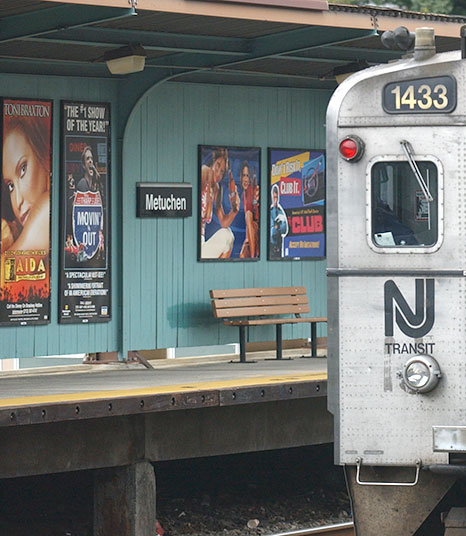By KATHY CHANG
Staff Writer
METUCHEN — In an effort to make borough streets safer for pedestrians, bicyclists and motorists, borough officials are working with RBA Group, a Parsippany-based engineering firm chosen by the New Jersey Department of Transportation (DOT), to provide assistance to the borough.
Mayor Peter Cammarano said the borough has made an effort to make its streets safer for pedestrians, bicyclists and vehicles.
“It started in 2013 by adopting a Complete Street Smart program,” he said.
In 2014, the borough received a Safe Routes to Schools grant, which will be used for a lighted crosswalk at Brunswick and Main avenues. Cammarano said there is no time frame set for the crosswalk as of yet.
In 2015, the borough reduced the speed limit on Grove Avenue from 35 miles per hour to 25 miles per hour, which Cammarano said has worked out pretty well for the most part.
“Speed does make a difference on that street,” he said.
In 2016, Metuchen was selected for the New Jersey Transportation Planning Authority’s (NJTPA) Street Smart New Jersey education campaign.
Metuchen was selected and is participating later in the year in the local, state-funded Pedestrian Biking assistance program organized by the NJDOT.
“The purpose is to make recommendations and identify opportunities that the borough may have,” he said.
Michael Dannemiller, of RBA Group, presented findings to the Borough Council at a meeting on Dec. 19.
“We are one of three on-call consultants for the NJDOT that do bike, pedestrian and traffic calming enhancements offering technical assistance contracts to municipalities who request them,” he said noting that requests are fairly competitive.
Dannemiller said they help with outreach and identifying issues and desires from the community.
“From there, we develop a plan starting with the open public process,” he said.
For future funding, Dannemiller said NJDOT wants to see that a steering committee was formed, that the borough did public outreach and created a planning document as a starting point.
Dannemiller said a public meeting was held where they provided blank maps and took suggestions and recommendations on where the problems are today, where the motor vehicle, pedestrian and/or bike crashes are happening, where the favorite destinations in the borough are and more.
“The focus was on how to improve pedestrian circulation in town,” he said to the Council. “We looked at how to get from one side of the borough to the other side without having to use a motor vehicle. We looked at the critical gaps of where you have sidewalks and where you don’t.”
Dannemiller said they discussed sidewalk continuation linking portions of sidewalks that already exist.
“Some of the recommendations were where more paint and signs, stripe curb extensions at crossings and high-visibility sidewalks are needed,” he said.
Dannemiller said another recommendation was to enhance bike accommodations in the borough.
“We looked at how to get into town and get out of town,” he said.
Dannemiller said they discussed working on between destinations to facilities, which would require signs and striping and optional bike routes.
“This is a starting point,” he said. “We put together a plan, but nothing is cast in stone. Nothing is pushed forward immediately. There will be more scrutiny before the final design.”
Dannemiller said shortened crossings at intersections can all be done with paint, which narrows the intersection and provides a decrease in time a pedestrian has to cross the street. He said dedicated bike facilities would have some parking impacts, and borough officials would have to find a balance.
“Anything can be modified,” he said.
Dannemiller said when looking at shortened crossings and bicycle lanes together, whether there is a bicyclist in the lane or not, traffic will slow down.
He said the borough could conduct a pilot test of the recommendations to see how they like it.
Dannemiller said they did a similar plan for Bay Head Township in Ocean County, which conducted a pilot using duct tape.
In another plan, officials in Cambridge, Massachusetts used water-soluble paint on Massachusetts Avenue between Massachusetts Institute of Technology (MIT) and Harvard University for a bike lane that lasted one weekend to garner reactions.
Dannemiller said he suggested starting easy with some recommendations.
“We want to make sure travel speeds are low and pedestrians are safe to walk along and cross the street to get from business to business without having to drive,” he said. “Stripe curb high-visibility crosswalks blend in well with Main Street for an old hometown feel.”
Resident Sean Massey suggested creating a parking benefits district.
“If [people] park in a given area designated as a parking benefit district, monies from those parking fees would go towards infrastructure for streetscape and bicycle, pedestrian facilities,” he said.
Massey said this has been utilized successfully elsewhere.
“I think it’s important when folks see the dollars they are paying allocated to infrastructure upgrades in the immediate area,” he said.
Massey said it is easy to talk about bike lanes and parking; however, it is about public safety first and foremost and an overarching topic of public health.
“I think a lot of folks who have kids envision sending one of them to bike to school [without being] petrified that something is going to go south or an elderly parent … I can send them downtown and not worry about them getting across the street,” he said. “This is about public safety and public health, not about parking and not about bike lanes. It’s all about how we can get safely around town and enjoy the benefits that derive from that.”

